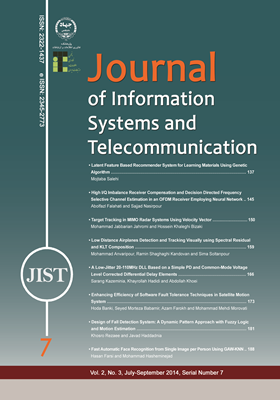-
-
List of Articles
-
Open Access Article
1 - Latent Feature Based Recommender System for Learning Materials Using Genetic Algorithm
Mojtaba Salehi -
Open Access Article
2 - High I/Q Imbalance Receiver Compensation and Decision Directed Frequency Selective Channel Estimation in an OFDM Receiver Employing Neural Network
afalahati afalahati Sajjad Nasirpour -
Open Access Article
3 - Target Tracking in MIMO Radar Systems Using Velocity Vector
Mohammad Jabbarian Jahromi Hossein Khaleghi Bizaki -
Open Access Article
4 - Low Distance Airplanes Detection and Tracking Visually using Spectral Residual and KLT Composition
Mohammad Anvaripour Sima Soltanpour -
Open Access Article
5 - A Low-Jitter 20-110MHz DLL Based on a Simple PD and Common-Mode Voltage Level Corrected Differential Delay Elements
Sarang Kazeminia Khayrollah Hadidi Abdollah Khoei -
Open Access Article
6 - Enhancing Efficiency of Software Fault Tolerance Techniques in Satellite Motion System
Hoda Banki babamir babamir Azam Farokh Mohammad Mehdi Morovati -
Open Access Article
7 - Design of Fall Detection System: A Dynamic Pattern Approach with Fuzzy Logic and Motion Estimation
Khosro Rezaee Javad Haddadnia -
Open Access Article
8 - Fast Automatic Face Recognition from Single Image per Person Using GAW-KNN
Hassan Farsi Mohammad Hasheminejad
-
The rights to this website are owned by the Raimag Press Management System.
Copyright © 2017-2025







